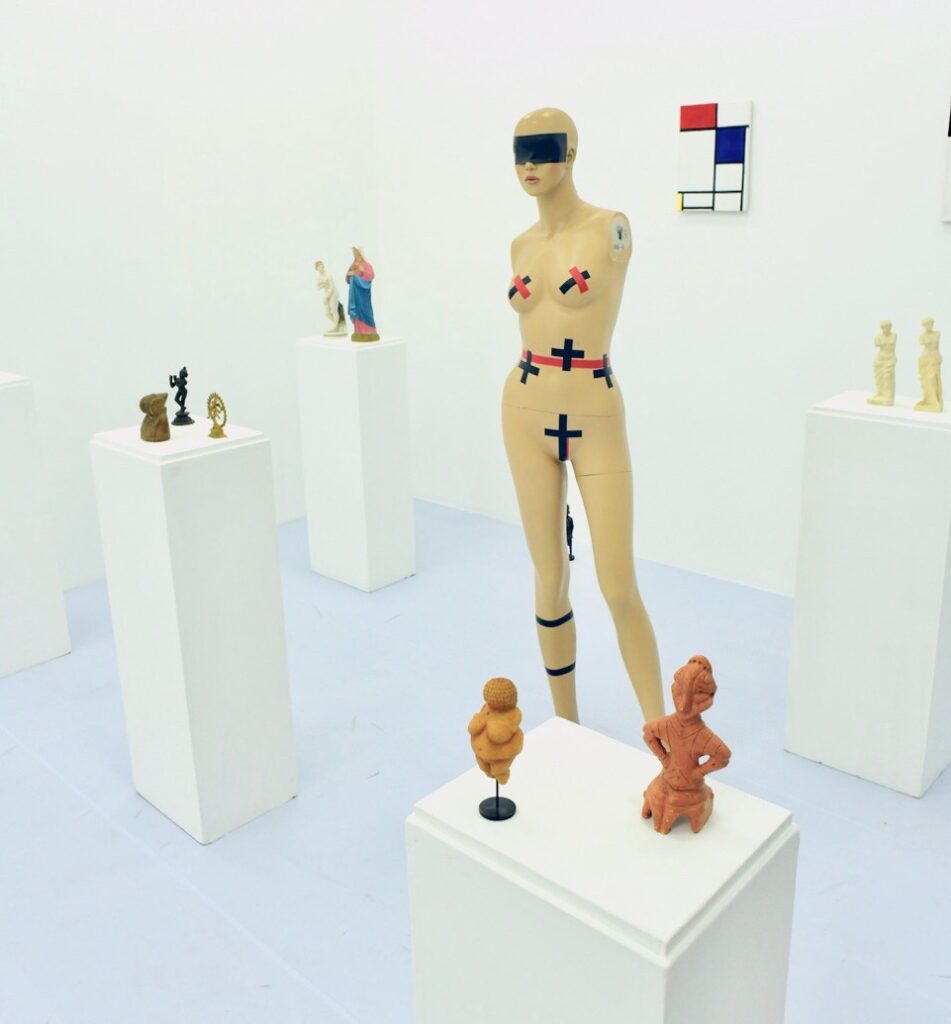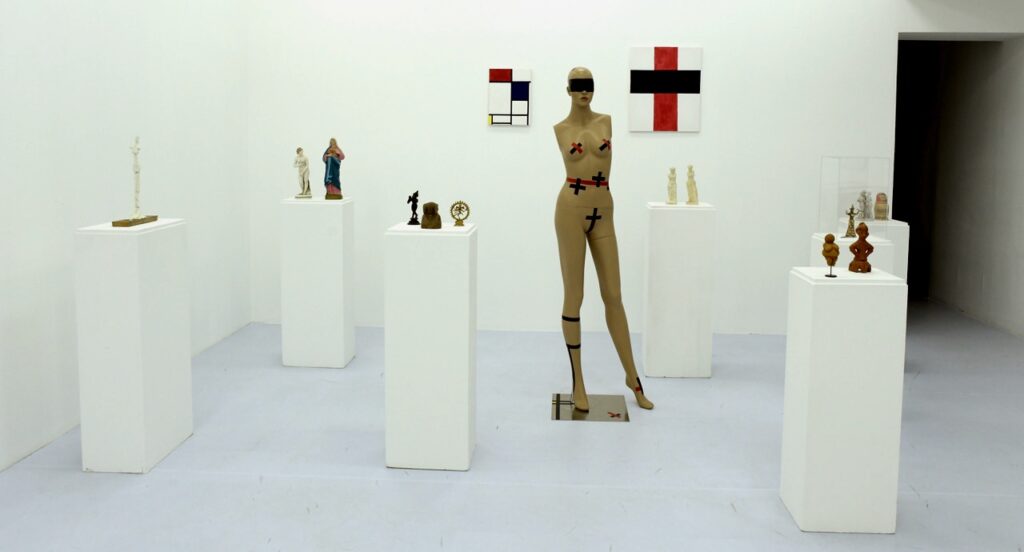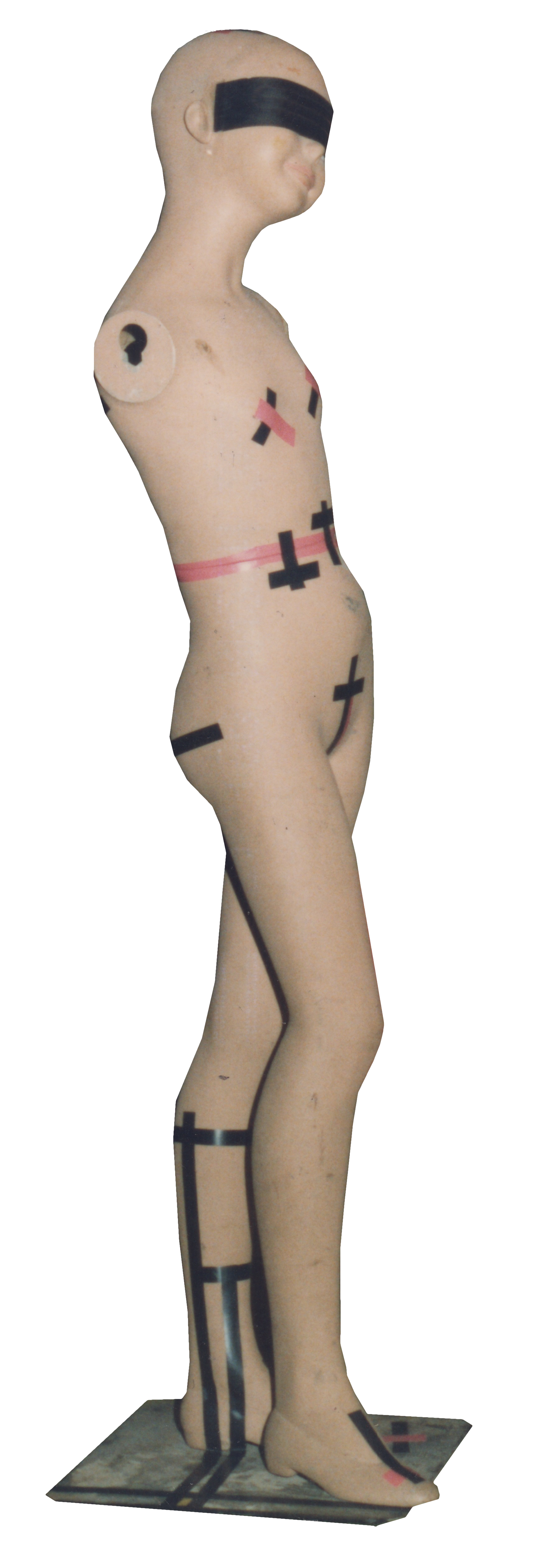< >
Supremaneoplast, 1984, FILOART
What is the purpose of this young-girl-disabled-body, standing with no hands and covered eyes (1)? Somebody who cannot see and cannot touch (2). Is this showroom dummy a contem- porary Venus de Milo, a reference to an antique sculpture or an underage model from the catwalk, or… ? In what context can we observed this work?
Two abstract (3) artists meet in one readymade. Each with his own style, Kazimir Malevich (4) with Suprematism and Piet Mondrian (5) with Neo-plasticism.
“Supremaneoplast” is a kind of art historic eclectic body, which deals with working themes of two artists of the same period. Their similarities and differences, their works and they works ban.
Surface and Form
The intervention in this work happens on different surfaces. One surface is the panel (2D) on the ground and the second is the figure (3D) over the panel.
Mondrian’s work (quotation) starts on the ground (panel) and continues going up high. This neoplastic is present with her two dimensions, on a two dimensional panel, stretching over the body of the three dimensional figure, but still remains wihtin
its two dimensions. While Mondrian’s work represents a kind of continuity from one dimension to another, Malevich’s works (quotations) are spread all over. They lie on the panel (on the ground), they are on the shoe of the figure, the body or the head. The Black Square over the Red Square or the Black Cross either have a function on this body or make it dysfunctional. These quotations, look like they are warping something (6). They cover (the eyes), protect, shield (the vagina, nipples, butt), or they expose and use the body as a screen.
_____________________________
1. There are noticeable parallels between the Supremaneoplast and some works by the two artists. For example: how people in some of Malevich’s Suprematism works were painted, without faces or without hands. In some of Mondrian’s works this phenomenon is also visible, that faces or hands disappear.
2. In the last phase of Malevich, (which he called Supranaturalismus), the people are portrayed in naturalistic form. He communicates with encrypted gestures of his figures. In his view “the life of man can be reduced to a gesture.”
3. In the beginning abstract art as an art movement was not accepted, it was mocked and also banned. For politicians abstract art was danger- ous, for the masses it was incomprehensible. Even for one part of the art scene abstract art was not recognized as art, but as design.
4. Malevich felt the brutality of the state very early. His works where exhibited in 1931 in the Tretjakow Gallery in the Soviet Union as “Bourgeois Art”. He was fired from SWOMAS where he was working as a professor. During the Soviet Union, his works were kept in depots. In 1930 Malevich was arrested and tortured by the Soviet OGPU in Leningrad – demanding a confession in espionage. Kazimir Malevich died from various health issues on May 15, 1935.
5. In 1937 in Munich, among the works of the modern artists Mondrian’s artwork was marked and exposed as Degenerated Art, by the Nazi regime.
6. A tape was used during this intervention, either to bind things together or for isolation.
Supremaneoplast, FILOART, 1984, “This is not en Exhibition
but the opposite of it” Youth Palast “Boro and Ramizi” Prishtinë, 1987
.
.

Supremaneoplast, FILOART, 1984-2019, “This is not en Exhibition but the opposite of it” National Gallery of Kosova, 2019
.

Supremaneoplast, FILOART, 1984-2019, “This is not en Exhibition but the opposite of it” National Gallery of Kosova, 2019
.

Supremaneoplast, FILOART, 1984-2019, “This is not en Exhibition but the opposite of it” National Gallery of Kosova, 2019

